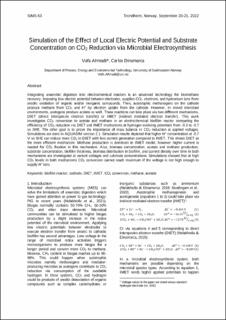| dc.contributor.author | Ahmadi, Vafa | |
| dc.contributor.author | Dinamarca, Carlos | |
| dc.date.accessioned | 2023-02-09T10:00:39Z | |
| dc.date.available | 2023-02-09T10:00:39Z | |
| dc.date.created | 2023-01-20T11:53:42Z | |
| dc.date.issued | 2022 | |
| dc.identifier.citation | Ahmadi, V., & Dinamarca, C. (2022, 20.-21. september). Simulation of the Effect of Local Electric Potential and Substrate Concentration on CO2 Reduction via Microbial Electrosynthesis [Paperpresentasjon]. Proceedings of the 63rd International Conference of Scandinavian Simulation Society, SIMS 2022, Trondheim. | en_US |
| dc.identifier.issn | 1650-3686 | |
| dc.identifier.uri | https://hdl.handle.net/11250/3049572 | |
| dc.description.abstract | Integrating anaerobic digestion into electrochemical reactors is an advanced technology for biomethane recovery. Imposing low electric potential between electrodes, supplies CO2, electrons, and hydronium ions from anodic oxidation of organic and/or inorganic compounds. Then, autotrophic methanogens on the cathode produce methane from CO2 and H+ by electron uptake from the cathode. However, in mixed microbial environments, acetogens produce acetate as well. These reactions can take place via two different mechanisms, DIET (direct interspecies electron transfer) or IMET (indirect mediated electron transfer). This work investigates CO2 conversion to acetate and methane in an electrochemical biofilm reactor comparing the efficiency of CO2 reduction via DIET and IMET mechanisms at hydrogen evolving potentials from -0.3 to -0.7 vs SHE. The other goal is to prove the importance of mass balance in CO2 reduction at applied voltages. Simulations are done in AQUASIM version 2.1. Simulation results depicted that higher H+ concentration at -0.7 V vs SHE can reduce more CO2 in DIET with less current generation compared to IMET. This shows DIET the more efficient mechanism. Methane production is dominant in IMET model, however higher current is needed for CO2 fixation in this mechanism. Also, biomass concentration, acetate and methane production, substrate concentration, biofilm thickness, biomass distribution in biofilm, and current density over time in both mechanisms are investigated at variant voltages and substrate concentrations. Simulations showed that at high CO2 levels in both mechanisms CO2 conversion cannot reach maximum if the voltage is not high enough to supply H+. | en_US |
| dc.language.iso | eng | en_US |
| dc.rights | Navngivelse 4.0 Internasjonal | * |
| dc.rights.uri | http://creativecommons.org/licenses/by/4.0/deed.no | * |
| dc.title | Simulation of the Effect of Local Electric Potential and Substrate Concentration on CO2 Reduction via Microbial Electrosynthesis | en_US |
| dc.type | Peer reviewed | en_US |
| dc.type | Journal article | en_US |
| dc.description.version | publishedVersion | en_US |
| dc.rights.holder | © 2022 Vafa Ahmadi, Carlos Dinamarca. | en_US |
| dc.source.volume | 192 | en_US |
| dc.source.journal | Linköping Electronic Conference Proceedings | en_US |
| dc.identifier.doi | https://doi.org/10.3384/ecp192006 | |
| dc.identifier.cristin | 2111460 | |
| cristin.ispublished | true | |
| cristin.fulltext | original | |
| cristin.qualitycode | 1 | |

